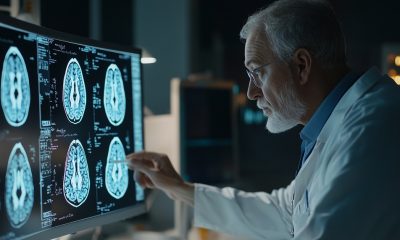Research
Reconnect: Music helps dementia patients connect with loved ones

Individuals with dementia will often lose their ability to verbally communicate with loved ones throughout the later stages of the disease.
A new study, which is a collaboration between Northwestern Medicine and the Institute for Therapy through the arts (ITA), displays how music intervention could help with communication.
The intervention called “Musical Bridges to Memory” was developed at ITA.
A live ensemble plays music from a patients youth, which allows them to create an emotional connection between patient and carer.
This connection is established through interaction with the music, through the likes of singing and dancing.
The programme also helped to develop patients social engagement and reduce neuropsychiatric symptoms, including anxiety and depression in both patient and carer.
Lead author of the study, Dr Borna Bonakdarpour, highlights the unorthodox approach of the study as it targeted both patient and carer, as previous studies involving music have only been directed at the patient.
Bondakdarpour says: “Patients were able to connect with partners through music, a connection that was not available to them verbally
“The family and friends of people with dementia also are affected by it. It’s painful for them when they can’t connect with a loved one.
“When language is no longer possible, music gives them a bridge to each other.”
Alzheimer’s and Music Memory
Memories of music will often remain in the brain, even after languages and other memories start to fade because of dementia.
This is due to the regions of the brain that are involved with music memory are not affected by Alzheimer’s, until much later in the course of the disease.
Thus meaning that patients can retain the ability to dance and sing along after their ability to communicate has diminished.
How the study was implemented
For the study, residents of Silverado Memory Care who have dementia, along with their care partners were recorded on video conversing and interacting 10 minutes before and then after the intervention.
Before music was played, each patient and carer pair received training on how to interact more effectively during the music.
During the musical intervention, which lasted 45 minutes, an ensemble of chamber musicians and a signer performed songs that appealed to the patients from their younger days.
The patients and carers were given simple instruments such as tambourines to accompany the music.
Specially trained music therapists interacted with patients during performances, getting them to beat on drums, as well as sing and dance.
After the music interventions, a group conversation would ensue.
Patients were noticeably more socially engaged as evidenced by more eye contact, less distraction and elevated mood.
In comparison to the control group, who did not receive the musical intervention and instead were exposed to usual daily care and programmes, they did not show such changes in the same time frame.
This programme included 12 sessions over a three month period.
Before the intervention, it was noticeable that some individuals would not communicate with their partners.
However, during the musical intervention the same individuals that would not communicate, started to dance, sing and play with their carer.
These changes also generalised to their behaviour outside the sessions as well.
Jeffrey Wolfe, a neurologic music therapist and leader of the Musical Bridges to Memory programme says: “It became a normalising experience for the whole family. All could relate to their loved one despite their degree of dementia.”
The next step for this study is to conduct the study on a larger group of patients.
News
Weight loss jabs my only temporarily reduce ‘food noise,’ study finds
News
Childhood loneliness linked to increased risk of dementia, study finds

Childhood loneliness increases the risk of dementia in later life, according to new research.
Adults who recalled being lonely and without a close friend in childhood faced a 41 per cent higher risk of developing dementia, even if they were no longer lonely as adults.
People who frequently felt lonely without close friends during youth showed accelerated cognitive decline — a worsening of memory and thinking — and started middle age with lower scores on these skills.
Researchers from universities in China, Australia and the US, including Harvard and Boston universities, analysed data from 13,592 Chinese adults tracked from June 2011 to December 2018.
The critical factor was the subjective feeling of loneliness itself. Those who reported often feeling lonely as children had a 51 per cent higher dementia risk, even if some had close friends.
However, those who only lacked close friends but did not feel lonely showed no significant difference in risk.
Nearly half of roughly 1,400 adults in the study reported being lonely and without close friends during childhood.
The 4.2 per cent who experienced both faced the highest risk of cognitive decline.
The link to dementia remained strong even for people who were no longer lonely in adulthood, suggesting early-life isolation can have lasting effects on brain health.
During childhood, the brain develops rapidly and is vulnerable to harm. Loneliness acts as a chronic stressor, flooding the developing brain with harmful hormones that can damage memory centres, and it reduces stimulation from social play and peer interaction that helps build robust neural networks.
A separate 2024 study of more than 10,000 older adults found that specific childhood hardships — including poverty, disruptive home environments or parental addiction — were directly linked to poorer cognitive function later in life.
Youth loneliness appears to be rising, partly linked to widespread social media use.
Among girls, 64 per cent aged five to seven, 67 per cent aged eight to 10, and 73 per cent aged 11 to 13 reported feelings of loneliness last year. More than a quarter of boys aged 11 to 17 in the US report feeling lonely.
Children face growing social isolation, with one in four Americans now eating every meal alone — a rate that has surged by over 50 per cent since 2003. Sharing meals with friends and family helps build bonds and positive memories in youth.
Fewer children are playing outside or joining team sports.
A recent study reported that one in three children do not play outside on school days, and one in five do not do so even at weekends.
The 2024 research found a direct, dose-dependent relationship between childhood adversity and cognitive problems in adults — the greater the early trauma, the greater the later risk.
For each significant increase in early trauma, individuals faced an eight per cent higher risk of daily memory issues and scored lower on objective tests of mental speed and focus.
News
One in 20 children has high blood pressure, study finds

Rates of high blood pressure in children have almost doubled since 2000, with more than one in 20 now affected, new global research shows.
In 2020, 6.2 per cent of under-19s had high blood pressure, compared with 3.2 per cent in 2000.
High blood pressure, also known as hypertension, now affects 114 million children worldwide, according to an international team including academics from the University of Edinburgh and Zhejiang University in China.
The authors examined data on 443,000 children from 21 countries and found obesity was a substantial driver of the problem.
Nearly 19 per cent of children and adolescents with obesity have high blood pressure, compared with 3 per cent among those with a healthy weight.
In England, one in ten (10.5 per cent) children in the first year of primary school is obese. By the final year, 22.2 per cent are obese, according to the National Child Measurement Programme.
High blood pressure occurs when the force of blood pushing against artery walls is consistently too high, which can damage blood vessels and organs over time.
Co-author Dr Peige Song of Zhejiang University attributed higher rates to unhealthy diets, decreased physical activity and rising childhood obesity.
She said: “The analysis showed that children and adolescents with obesity are nearly eight times more likely to develop hypertension.”
“Parents play a pivotal role in preventing and managing high blood pressure in children.
“Promoting healthy habits, such as a balanced diet rich in fruits, vegetables and whole grains while minimising salt and sugar intake, can substantially reduce the risk of hypertension.”

 News2 months ago
News2 months agoTool could detect early signs of Alzheimer’s

 News4 weeks ago
News4 weeks agoYounger Britons more worried about dementia than older generations, new poll reveals

 Independence1 week ago
Independence1 week agoNHS issues heart valve plea after donations dip

 Insights1 month ago
Insights1 month agoEmotional well-being as important as physical for longevity, study finds

 News3 weeks ago
News3 weeks agoAlayaCare buys Nightingale to expand ANZ aged care

 News5 days ago
News5 days agoDon’t miss you essential monthly agetech update

 News1 month ago
News1 month agoGeorgia centre wins funding for falls prevention

 News3 weeks ago
News3 weeks agoCareScout completes Seniorly acquisition

































